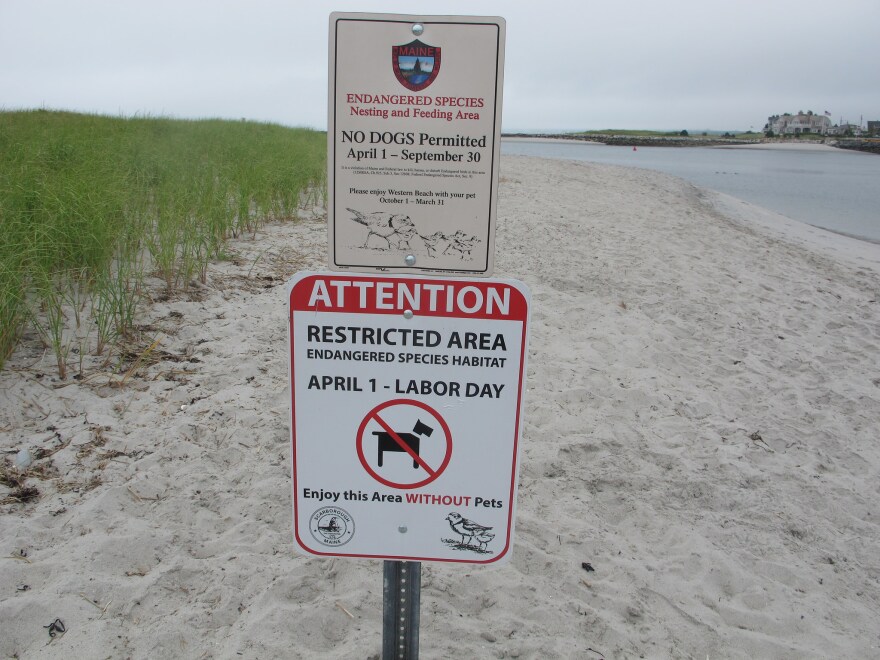SCARBOROUGH, Maine - It's been a good season for the endangered piping plover. Populations of the tiny migrating shorebirds, that like to nest on the sandy beaches of southern and Midcoast Maine during the summer, were perilously low a few years ago. But this year, thanks in large part to the efforts of local communities, monitors have observed the highest numbers on record.
Ryan Wynne walks along Ferry Beach in Scarborough, towards Western Beach, which lies adjacent to it. Both shorelines, he says, are favorite summer nesting places for piping plovers.

Wynne is the beach-monitoring coordinator for the town of Scarborough. He was hired last spring to keep an eye on shorebird nesting areas and educate the public about how they can avoid harming the piping plovers - small, white-breasted creatures with matchstick legs.
"It's been a good 15 months," Wynne says. "You can look at the numbers: We've had increased fledging rates, the number of pairs on our beaches, the amount of volunteers we've been getting for our program has increased steadily since last year."
Wynne oversees 46 volunteers, covering Scarborough's four beaches. One of them is retired schoolteacher Glennis Chebot, who patrols nearby Higgins Beach twice a day from April until September. She looks for nests and is also there to educate members of the public - especially dog owners.
"People are not sign readers," Chebot says. "You know, we have signs posted everywhere. I understand that because I'm not a real sign reader, you know. Don't put anything up at Hannaford you want me to read because I'll never see it."
The killing of a nesting plover two years ago by an unleashed dog on Pine Point Beach resulted in a new town beach ordinance restricting canine activity. Half of Higgins Beach is now closed to dogs over the summer, says Chebot, while the other half allows supervised pets off the leash between 7 a.m and 9 a.m. No dogs at all are permitted on the beach between 9 a.m. and 5 p.m., when they're allowed back for a further three hours - as long as they're leashed.

Chebot says most local residents are now aware of the rules and follow them. But it's often a different story, she says, for summer visitors. "We have so many new people here every day that aren't aware of the rules, so we talk to a lot of people."
"And what's the response you typically get?" I ask.
"A lot of support, a lot of support," she says, "a lot of 'thank you's' for doing this."
But not everyone was happy with the new restrictions. "Certainly there was resistance," says Scarborough Town Manager Tom Hall. Hall says there was no question that action had to be taken: The dog attack incurred the wrath of the U.S. Fish and Wildlife Service, which threatened the town with a $12,000 fine.
Hall says the crafting of the ordinance was something of a balancing act. "Oftentimes my job - I do find myself trying to find that happy place in the middle. And our beaches are something that, for obvious reasons, everyone wants access to. And I think this is a demonstration that there are ways to craft public policy and rules and regulations the achieve that level of balance. Is everyone entirely happy? Probably not."
Certainly the feds were not entirely happy, says Hall. They would prefer no unleashed dogs on the beach at all during that critical nesting period. Nevertheless, they still welcomed the new ordinance and dropped the threat of a fine.
And they may be encouraged by the latest statewide numbers, which show 62 nesting pairs of piping plovers and 121 fledgling chicks - the best figures since intensive monitoring began in 1981, says Laura Zitske, from Maine Audubon's Piping Plover and Least Tern project.
Zitske says the results are, in large part, due to the hard work of people in places like Scarborough. "We have people in all the communities, really, taking ownership over the beach and over the birds and watching out for them, and educating people."
Meanwhile back on Western Beach in Scarborough, it looks like the remainder of this season's piping plovers have departed, explains Ryan Wynne, as he points to the stretch where the last nest had been.
"When did you last see one here?" I ask.
"A couple of days ago, so I think it's pretty safe to say that they've flown the coop," he says.
"Summer is over, it's official," I say.
"It's over," he agrees. "The plovers are gone." Gone south, he says, heading to the Mid-Atlantic before wintering in the Bahamas: not a bad life, if you can avoid the predators.



